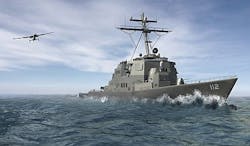DARPA TERN program seeks to operate long-endurance UAVs from fleets of small ships
ARLINGTON, Va., 5 March 2013. U.S. government researchers are trying to develop a medium-altitude long-endurance unmanned aerial vehicle (UAV) for long-term maritime surveillance that can launch and recover from small ships to provide airborne intelligence, surveillance and reconnaissance (ISR) and strike mobile targets anywhere, around the clock.
Scientists at the U.S. Defense Advanced Research Projects Agency (DARPA) in Arlington, Va., are trying to create this capability through the Tactically Exploited Reconnaissance Node (TERN) program, which seeks to develop technology to enable small ships to serve as mobile bases for UAVs.
DARPA experts will brief industry on the TERN program objectives during a proposer's day workshop from 9 a.m. to 4 p.m. on 20 March 2013 at the DARPA Conference Center, 675 N. Randolph St. in Arlington, Va.
The TERN program seeks to overcome limitations of aircraft surveillance. Helicopters are relatively limited in the distance and flight time, for example, while fixed-wing manned and unmanned aircraft can fly farther and longer but require either aircraft carriers or large land bases with runways often longer than a mile.
The TERN program seeks to combine the strengths of aircraft bases on land and sea, by using small ships as mobile launch and recovery sites for medium-altitude long-endurance (MALE) fixed-wing UAVs.
Named after the family of sea birds known for flight endurance, TERN aims to make it much easier, quicker and less expensive for the U.S. military to deploy ISR and strike aircraft almost anywhere in the world, DARPA officials say.
DARPA will ask industry to develop a MALE UAV and an automated launch and recovery system. The UAV would must be able to carry a 600-pound payload and fly as far as 600 to 900 nautical miles from its host vessel.
The launch and recovery system must fit a U.S. Navy Independence-class littoral combat ship (LCS-2) and other surface warships as feasible, DARPA officials say.
The TERN program envisions a capability "like having a falcon return to the arm of any person equipped to receive it, instead of to the same static perch every time,” says Daniel Patt, the DARPA TERN program manager.
“About 98 percent of the world’s land area lies within 900 nautical miles of ocean coastlines," Patt explains. "Enabling small ships to launch and retrieve long-endurance UAVs on demand would greatly expand our situational awareness and our ability to quickly and flexibly engage in hotspots over land or water.”
Key technical challenges include devising a reliable launch and recovery technique to enable large aircraft to operate from small ships, even in rough seas; designing an aircraft with range, endurance, and payload comparable to emerging land-based unmanned aircraft with minimal ship modifications; and packaging the system to fit into the limited space aboard ships.
DARPA plans to roll out TERN in three phases over about 40 months, culminating in a full-scale launch and recovery demonstration.
Those interested in attending the TERN program industry briefings should register no later than 18 March online at www.schafertmd.com/darpa/tto/TERN.
More information is online at https://www.fbo.gov/index?s=opportunity&mode=form&id=4af82338eb6efdf4cfafb3a21ec72004&tab=core&_cview=0.

